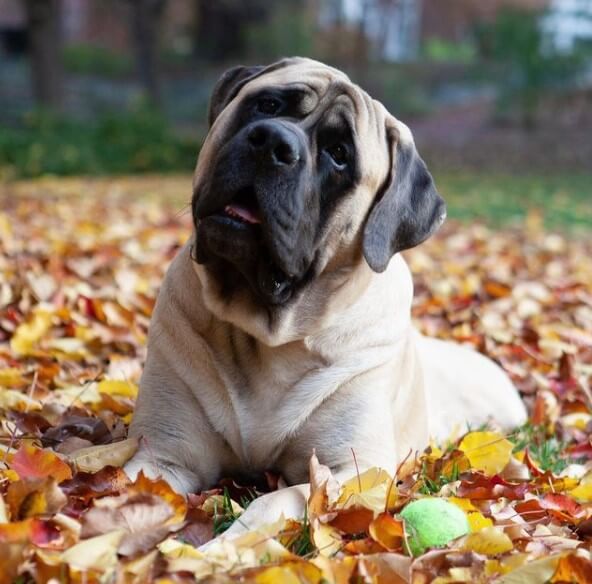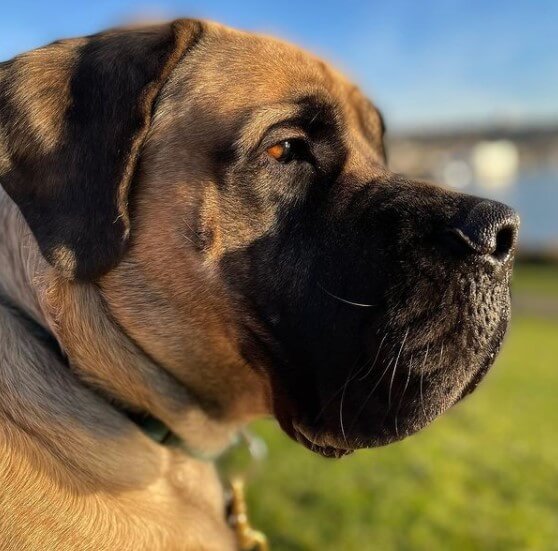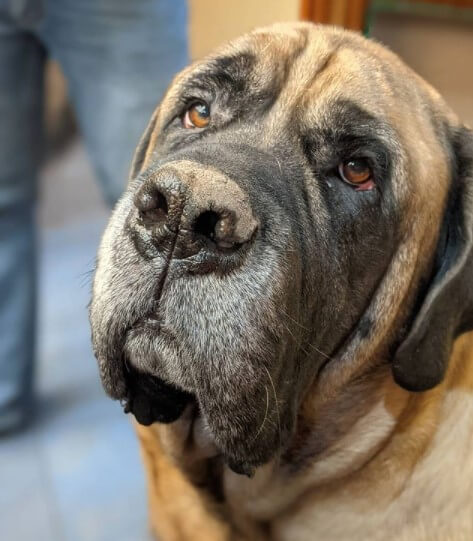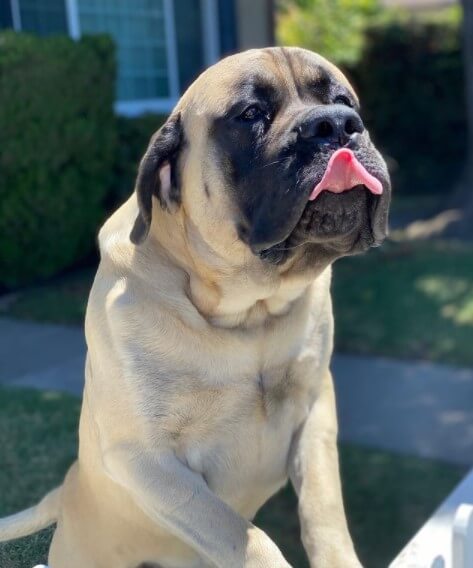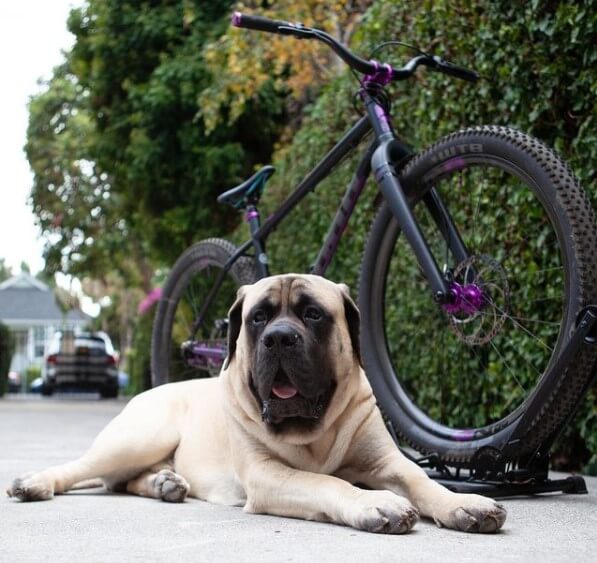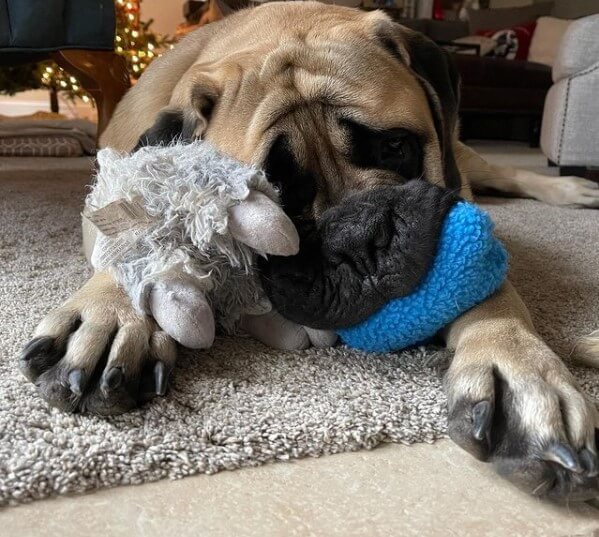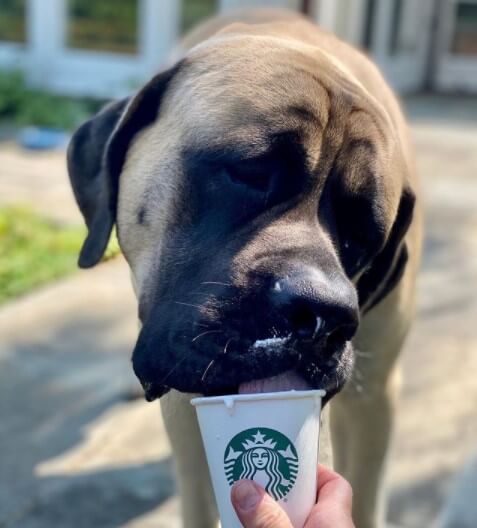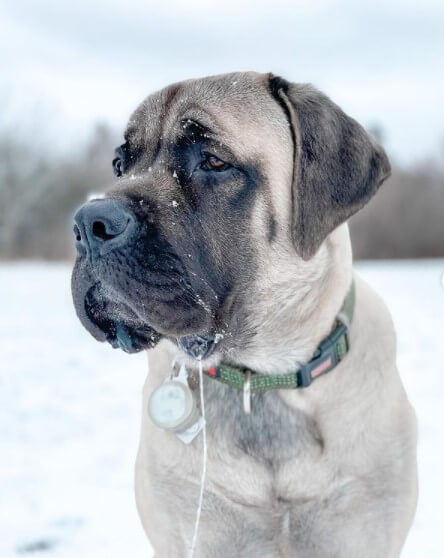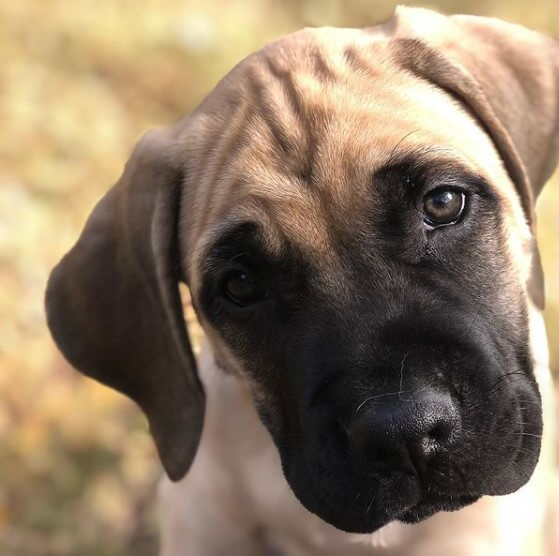The English Mastiff is an emigrant from Foggy Albion and a representative of one of the oldest dog breeds. This powerful defender is famous for his brave heart and unshakable self-confidence – he inherited such valuable qualities from his distant ancestors. The history of the English Mastiff is as multifaceted as the breed itself. There were cruel moments and auspicious events, bloody wars and peacetime, royal life and wanderings worthy of the poor. Despite the ambiguous fate, the Mastiffs managed to preserve age-old wisdom and steel endurance. It’s hard not to pay attention to these impressive and powerful dogs!
Brief Information
- Breed name: English Mastiff
- Country of origin: United Kingdom
- Weight: males about 72 kg, females about 68 kg
- Height (height at the withers): males from 76 cm, females from 69 cm
- Life span: 9-11 Years
Key Facts
- It is worth learning from the representatives of the breed calmness and steadfastness: these impressive dogs are difficult to unsettle.
- Mastiffs are distinguished by their strong affection for the owner and express their love by “calling” to embrace and soak up the couch together.
- Between an extra walk and a rest in the warmth of the family hearth, the “British” will choose the latter: these dogs love to stay at home.
- Despite the kindness and responsiveness, the representatives of the breed make excellent guards.
- English Mastiffs are not suitable for families with small children and people with an overly active lifestyle.
- Despite the kindness and responsiveness, the representatives of the breed make excellent guards.
English Mastiffs are not suitable for families with small children and people with an overly active lifestyle.
With timely socialization, these dogs get along well with other pets, sometimes competing with them. - Learning commands is by no means a priority for the breed, so it will take some effort to train fruitfully.
- Dominant character and natural stubbornness are the main reasons why English Mastiffs are not suitable for beginners.
History of the English Mastiff Breed
English Mastiffs cannot boast of a reliable version of the origin. The history of their existence is calculated for more than one millennium, and it is difficult for modern dog handlers to establish which of the two theories is correct. The first one says: “Englishmen” descended from massive and hardy animals, which were bred for hunting big game or organizing gladiatorial battles. The second version confirms the native English origin of animals.
It is known that Mastiff-like dogs existed in the era of prosperity of the ancient states – Persia, Greece, Egypt, and Babylon – and were quite popular among the nobility and common people. Mastiffs were widely used as a draft force, as well as for baiting wild boars, wild horses, and even large predators – tigers and lions. In their free time from hunting, the dogs successfully coped with the protection of property and livestock.
Participation of animals in bloody wars was no less important. Mastiff-like dogs were prized alongside well-trained soldiers. Preserved historical documents that confirm the existence of the canine “army” of Alexander the Great, which included about 50 thousand animals! These four-legged fierce warriors instilled fear in the enemy army, forcing it to raise the white flag ahead of time. With the help of dogs, the commander conquered Persia in the 5th century BC. e. and acquired a new title – the king of Asia.
The ancestors of the English Mastiff were also kept by another military leader – Gaius Julius Caesar. Animals were brought to the Roman Empire in the second half of the 1st century BC. e. Prior to this, the commander’s legions landed on the territory of Britain, where they met with huge dogs. According to Roman soldiers, the animals resembled lions in their size and were distinguished by an equally fierce disposition. These dogs are descended from the Babylonian Mastiffs, who came to Britain with Phoenician merchants long before the emergence of an all-powerful empire.
After the collapse of the empire, the dogs did not lose their popularity. Over time, they spread throughout Europe, forming small groups, from which later new breeds were formed – in particular, the Great Dane and Bordeaux. British dogs changed their roles, settling in the royal guards and hunting grounds of the aristocrats. Commoners were forced to refuse to keep these animals because of their huge size: to feed such a dog is not an easy task.
The peak of the popularity of Mastiff-like dogs fell in the first half of the 13th century when it became known about the unusual act of a female fighting dog belonging to the English nobleman Sir Pir Lee. She became famous for fiercely guarding the body of the wounded master during the battle of Agincourt until reinforcements arrived in the city. Then they looked at the animals in a different way, noting not only outstanding physical data but also amazing dedication. It was the latter that became the starting point, after which the first Molossian kennel appeared in Britain. The English line of the breed originated from Pir’s favorite. The gratitude of the aristocrat was so great that he raised all the puppies of his dog and took care of their further fate. In addition, Sir Lee took an active part in the life of the new nursery.
People’s perception of Mastiffs changed during the Renaissance. Queen Elizabeth I, who was famous for her love of cruelty and bloodshed, performed animal battles in every possible way. For this, the Molossian dogs turned out to be rather clumsy. Crossing them with Bulldogs made ideal candidates for dog pits. A new breed later developed from these animals – the Bullmastiff.
Now in the character of massive dogs, one can hardly notice the bloodthirstiness of their ancestors. England’s Mastiffs are ranked 27th on the list of the most popular breeds in the United States: these animals make excellent companions and loyal friends.
Appearance
The English Mastiff belongs to large breeds. Despite its size, the dog looks proportional. Individuals of the female are more graceful and light, the gender type of the animal is pronounced.
The parameters defined by the breed standard are impressive. The height of a female dog at the withers reaches 69 cm and above, the growth of males starts from 76 cm. With regard to body weight, it reaches 68 and 72 kg, respectively. Individual dogs can weigh up to 86 kg.
Coat and Color
Representatives of the breed are covered with thick and short hair, which is close to the body. Harsh to the touch, especially in comparison with a thicker undercoat.
The main color of the Mastiff is brindle, silver, apricot, deer and yellowish-brown variants. The ears are always black regardless of the color of the coat. The same goes for the “mask” on the dog’s face.
Personality
There is no trace of the fighting past of the English Mastiff. Modern representatives of the breed are calm and friendly dogs that show amazing consistency before mood swings. In the character of these animals, traits of immigrants from Old England can be traced: tolerance, reliability, and greatness. Mastiff knows his worth, never stoop to puppy pranks, and behaves with such nobility that individuals of royal blood are involuntarily remembered. At first glance, the dog seems to be an inveterate phlegmatic, but it is not. Deep down, the “English” have an amazing love for their family members.
The affection of Mastiffs can be intrusive (in the literal sense): these dogs love strong hugs, so at the slightest opportunity they will jump on their knees to the owner. Considering the weight of the animal, you should forget about strength training in the gym: just “carry on your hands” a pet weighing 70 kg!
English Mastiffs need constant company, although they do not “talk” about it. If a working schedule or a loose lifestyle does not allow spending time with a dog, it is better to give up the desire to have a representative of this breed. Loneliness is the worst punishment for Mastiffs. In desperation, the animal will try to entertain itself on its own, and this in any case will damage your apartment.
Although representatives of the breed are considered quivering and gentle giants, they do an excellent job of guarding duties. The guardian instinct of a dog extends not only to the territory but also to its family members. Having met an uninvited guest, the Mastiff will never run into the attack first: its impressive size is more than enough. Most likely, the animal will drive the stranger into a corner, where it will “leave” him until the owner returns. However, if it comes to a fight, the dog will never yield to the enemy, even at the cost of his own life.
Mastiff treats strangers no less wary. The animal almost never comes into contact with a stranger. Moreover: the “Englishman” will stand between him and the owner until he is convinced that there is no danger. Even frequent guests in your house will not be able to evade the gaze of the Mastiff, ready to rush to protection at any moment. Dogs rarely attack, so the only thing you should be wary of is the lack of free space on the couch. The Mastiff usurps this “territory” in the most impudent way.
These dogs are not suitable for families with small children – largely due to their size. In the midst of a fun game, the animal can accidentally push the baby and injure him. If you are unshakable in the urge to make a four-legged friend for your child, look for a less traumatic breed.
Representatives of this breed are kind to their relatives – both strangers and their “neighbors” in the apartment. Properly brought up Mastiffs can put up with the company of cats; even to decorative rodents and birds locked in cages, dogs are indifferent.
When making a choice in favor of the Mastiff, you should not be afraid of the combat past of this breed. The character of the pet depends solely on the participation of the owner in his upbringing and socialization. What features will be accentuated will prevail in the character of the “Englishman”, therefore the main task of the owner of the dog is to “mold” a calm and friendly animal out of it.
Training
The upbringing of the Mastiff should be started as early as possible, namely from the first day the animal appears in the house. The kid must learn the main rule: the title of leader is assigned not to him, but to you. Stop the slightest attempts of the “Englishman” to show willfulness and even aggression, but in no case beat the pet. Mastiffs love tenderness and affection, but they need a steady hand. Your task is to find a middle ground.
The main secret of effective teaching of the English Mastiff is the positive consolidation of what has been learned. Remember to compliment your pet and reward his behavior with a treat. It is better to refuse the increased tone of voice and blows.
To avoid potential problems, dog handlers recommend adhering to a certain daily routine. The Mastiff will be much more willing to fulfill your command if he knows that delicious dinner and a long-awaited dream await him soon. Training should take at least an hour. Learn the commands gradually, remembering to repeat the material already covered. Do not force your pet to repeatedly perform a trick just because you are bored: it will not be difficult for the English Mastiff to reveal these selfish intentions, and then you can forget about the fruitful study of commands. Representatives of the breed are well aware of the level of their intelligence, so they will not want to play the role of a puppet.
The inquisitive mind of the dog can lead to another problem: the English Mastiff will easily find your weak point and be able to manipulate. Do not forget to be cunning in dealing with your pet, do not succumb to his pitying glances and, if necessary, consult a professional trainer. These little tricks will help bring up an agreeable and intelligent gentleman from an obstinate dog.
Care
Caring for Mastiffs is not difficult, and this is the merit of the short hair of the dogs. It is enough to comb out once every two to three weeks, during the seasonal molt – a little more often. Use a stiff-bristled brush to remove dead hairs. Special gloves with silicone spikes are not suitable for this procedure. Cloth or suede will help give the English Mastiff a healthy sheen. This will make your pet even more neat and well-groomed.
Mastiffs do not need frequent water treatments. Some owners of these dogs are completely limited to grooming with dry shampoo. It is worth bathing the animal completely only as needed. To do this, use a special pet remedy: “human” shampoos often cause skin irritation and even hair loss. After the mastiff takes a bath, make sure that the dog is not lying in a draft. This is fraught with colds.
After a long walk (especially in windy weather), do not forget to carefully examine your pet’s ears and wipe them with a moistened cotton swab. For a drying effect, you can use a weak boric acid solution or another special agent from a pet store.
The same goes for the eyes of the English Mastiff. Examine them as often as possible and clean them with strong tea or chamomile decoction. Abundant discharge of an unhealthy color is an alarming sign. A timely visit to the veterinary clinic will help prevent inflammation.
The “Englishman’s” oral cavity needs no less care. Cynologists recommend brushing your dog’s teeth weekly, armed with a brush or compact finger attachment. In extreme cases, you can get by with a bandage folded in several layers. Do not forget that due to the peculiarities of the bite, English Mastiffs practically do not use their back teeth, so you will have to monitor the safety of their enamel.
Don’t forget about the dog’s claws. Despite the fact that they are mostly ground during a walk, it is worth periodically using a pruner for large breeds to relieve the pet of discomfort.
Feeding
Feeding the Mastiff is not an easy task. Due to its impressive size, the dog consumes a lot of food, so in this regard, the maintenance of the dog is very expensive. There are two possible diets – premium ready-to-eat foods and organic foods. The first option combines microelements necessary for full development, while the second implies careful development of the Mastiff menu and the intake of vitamins.
The diet of the English Mastiff should not contain:
- milk (if the animal is older than four months);
- foods high in carbohydrates;
- lamb or pork (due to fat content);
- food with a huge amount of spices;
- tubular bones of any size;
- delicacies from the “human” table;
- raw or boiled river fish;
- “Caffeine” drinks;
- mushrooms in any form;
- berries with seeds;
- legumes;
- smoked meats;
- sweets.
The dog’s bowl should be filled with fresh, unboiled water. English Mastiff owners advise using bottled.
Representatives of the breed feel equally comfortable both in apartments and in a private house – however, only on condition of timely and long walks. Mastiffs need daily physical activity, but at the same time, they are rather clumsy and lazy. The owner of the giant will have to make an effort to interest his pet.
The English Mastiff is a great company for sedentary people. Animals have a fairly long walk in the park, they are indifferent to agility and chasing flying saucers. Walking in hot weather Mastiffs are categorically contraindicated. This is due to the brachycephalic type of muzzle, which makes it difficult for the dog to breathe.
Overly clean and aesthetes should consider buying another breed. English Mastiffs are distinguished by profuse salivation, eating carelessly, snoring loudly, and, moreover, suffer from flatulence. If you are not ready to put up with it, choose other dogs.
Health
Despite the “iron” immunity and high life expectancy, representatives of the breed suffer from certain ailments. Among the most common diseases of Mastiffs are:
- dysplasia of the hip joints;
- volvulus of the stomach or intestines;
- osteoarthritis of the knee joints;
- stretching of the heart walls;
- urolithiasis;
- eversion and inversion of the century;
- breathing problems;
- redness of the eyes;
- intestinal obstruction;
- bloating;
- cataracts.
It is strictly forbidden to engage in independent treatment of the Mastiff if symptoms of the disease are detected. A timely visit to a veterinarian is a guarantee of good health and long life of your pet.
How to Choose a Puppy
The best place to buy an English Mastiff is the official nursery, where you can find a healthy and flexible baby with good genes. The main selection criterion is the character. Families with children should pay attention to puppies with a less dominant disposition, which will not fight for leadership and test the owner’s authority for strength.
The same selection rule applies to families where other dogs already live.
The dominant type of character “Englishman” is suitable only for people with experience of keeping large breeds of dogs. Be ready to constantly fight for supremacy in the “pack” and accept the challenge from the Mastiff. However, proper upbringing and timely socialization will make an obedient and friendly companion, even from a born leader.
Cynologists recommend buying puppies between the ages of one and a half to three months. Dogs are already distinguished by stable psychological health and are ready for an independent life. Inspect your potential pet carefully before purchasing. The fur of a little Mastiff should be shiny, eyes and eyes – clear, nose – wet and cold. Pay attention to the conditions of keeping babies, ask the breeder to present the necessary documents, and a certificate of timely vaccination. It will also be useful to get to know the puppy’s parents: this will help you get the first impression of what to expect from your four-legged friend.
